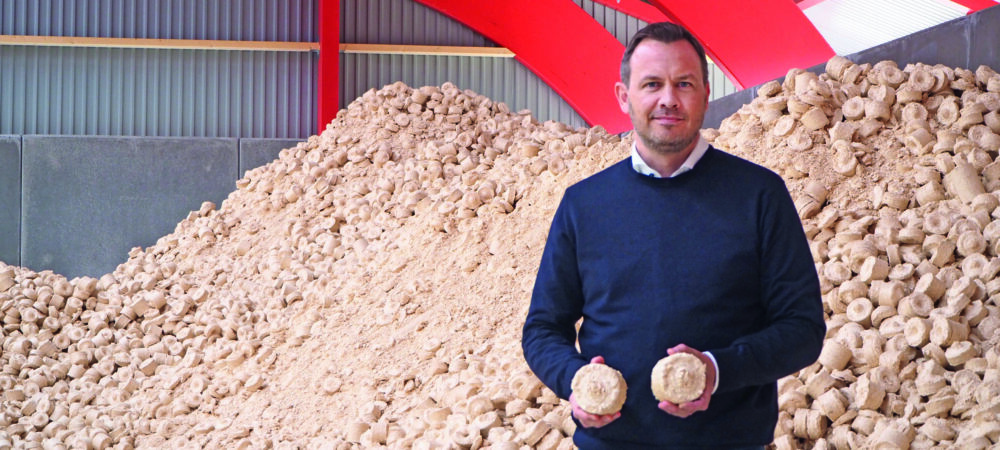
Lilleheden converts sawdust and wood shavings to the delight of local district heating plants
The glulam producer Lilleheden A/S in Hirtshals has just invested millions in a new and innovative briquette press, which converts surplus wood from the production of glulam beams into sustainable and storage-friendly wood briquettes. And Hirtshals Fjernvarme, among others, can now benefit from that investment. When the briquettes are burned at Lilleheden, the heat is sent directly to the local district heating customers. Hirtshals Fjernvarme is pleased that Lilleheden, with the briquette press, will be able to increase heat production in the winter months, so that the heating plant can turn down the gas.
While home owners, who today rely on gas and oil, are busy finding new ways to heat their houses, the country’s district heating plants are experiencing an increasing interest in connection. The increased number of customers means that many heating plants have to think in new ways when expanding heat production.
Hirtshals Fjernvarme is one of the district heating plants that was early on in terms of finding alternative ways to supplement its heat production. In 2001, they entered into a supply agreement with the glulam producer Lilleheden in Hirtshals, which means that the heating plant today takes surplus heat from the timber company, which is sent directly into the district heating network via a special connection. Originally, the heat came from burning wood shavings, which the company had in surplus from the production of glulam beams, but in the winter months the quantity of wood shavings is unfortunately limited. With Lilleheden’s new investment in a briquette press, the wood company has now made it possible to transform shavings and sawdust so that they can be stored all year round to the delight of, among others, the customers of Hirtshals Fjernvarme. Børge Vinther, chairman of the board of Hirtshals Fjernvarme, explains:
“One of the challenges of using wood shavings as fuel is that they are susceptible to moisture, very unmanageable and therefore difficult to store for the winter, when our customers freeze the most. But at Lilleheden – as with so many other manufacturers in the construction industry – the largest production takes place in the summer, when the weather is good, and we therefore do not need particularly much heat. We are therefore pleased that Lilleheden has now invested in an innovative briquette press that makes it possible to compress their chips so that they can be stored and used in the cold months. It is both a sustainable way of thinking and good for our customers,” says Børge Vinther.
Hirtshals Fjernvarme expects to be able to turn down the gas
Hirtshals Fjernvarme, which originally based all its heat production on gas, today gets its heat from three different energy sources. 15 percent of the heat comes from Lilleheden’s burning of surplus wood, while 80 percent comes from waste incineration at Affaldsselskabet Vendsyssel Vest (AVV). In addition, Hirtshals Fjernvarme itself produces five percent of the heat consumption on its own gas boilers. With the prospect of being able to get a more flexible supply of excess heat from Lilleheden in the winter months, Børge Vinter hopes that the heating plant can now turn down the gas a little.
Today we have just over 2,500 consumers connected to the supply network, but we expect more to be added over the next few years, because many households are switching from oil and gas boilers to other solutions. It is therefore very welcome that we can now increase the heat supply from Lilleheden in periods, as it simply does not make economic sense to produce more heat on our own gas boilers. Hopefully, we will even turn down the gas, as deliveries from, among others, Lilleheden become larger, concludes Børge Vinther.
An investment in the millions
In addition to the acquisition of the new briquette press, Lilleheden has also established a new warehouse for storing the wood briquettes – a total investment of just over four million kroner. Director at Lilleheden, Christian Esbensen, considers the investment a natural step in making the company, which already uses wood from FSC-certified forests, even more sustainable and looks forward to the next chapter in the collaboration with Hirtshals Fjernvarme.
“Previously, we had to supplement our wood shavings with purchased wood chips in the winter months to ensure enough heat for Hirtshals District Heating. Now we will be 100 percent self-sufficient in fuel, because we can transform and store the surplus wood from the summer’s production. It is good for both the environment, the climate and the economy,” says Christian Esbensen and continues:
“In addition, in the future we will not have to drive our wood shavings away in the summer, when there is no heating demand from the district heating customers. So far, we have sold the shavings to companies that convert them into, for example, wood pellets or animal bedding. With the new briquette press, we become even more sustainable, because we use our wood residues in the most optimal way and reduce transport costs for disposal.”
Wood briquettes as a local alternative to chips and pellets
It is not only Hirtshals Fjernvarme that will benefit from the new briquette press. Lilleheden has more wood shavings than Hirtshals Fjernvarme needs. Lilleheden is therefore already in dialogue with several local district heating plants in Vendsyssel, who may be interested in buying wood briquettes for their own boilers. It is especially the works that already use wood chips or wood pellets for which the solution is interesting.
“It is our opinion that the war in Ukraine also affects the supply chain of wood pellets and wood chips. With the new briquette press, we can offer the surrounding district heating plants a locally produced alternative in the form of wood briquettes that fit in their existing boilers and which do not have to be transported over long distances,” explains Christian Esbensen.